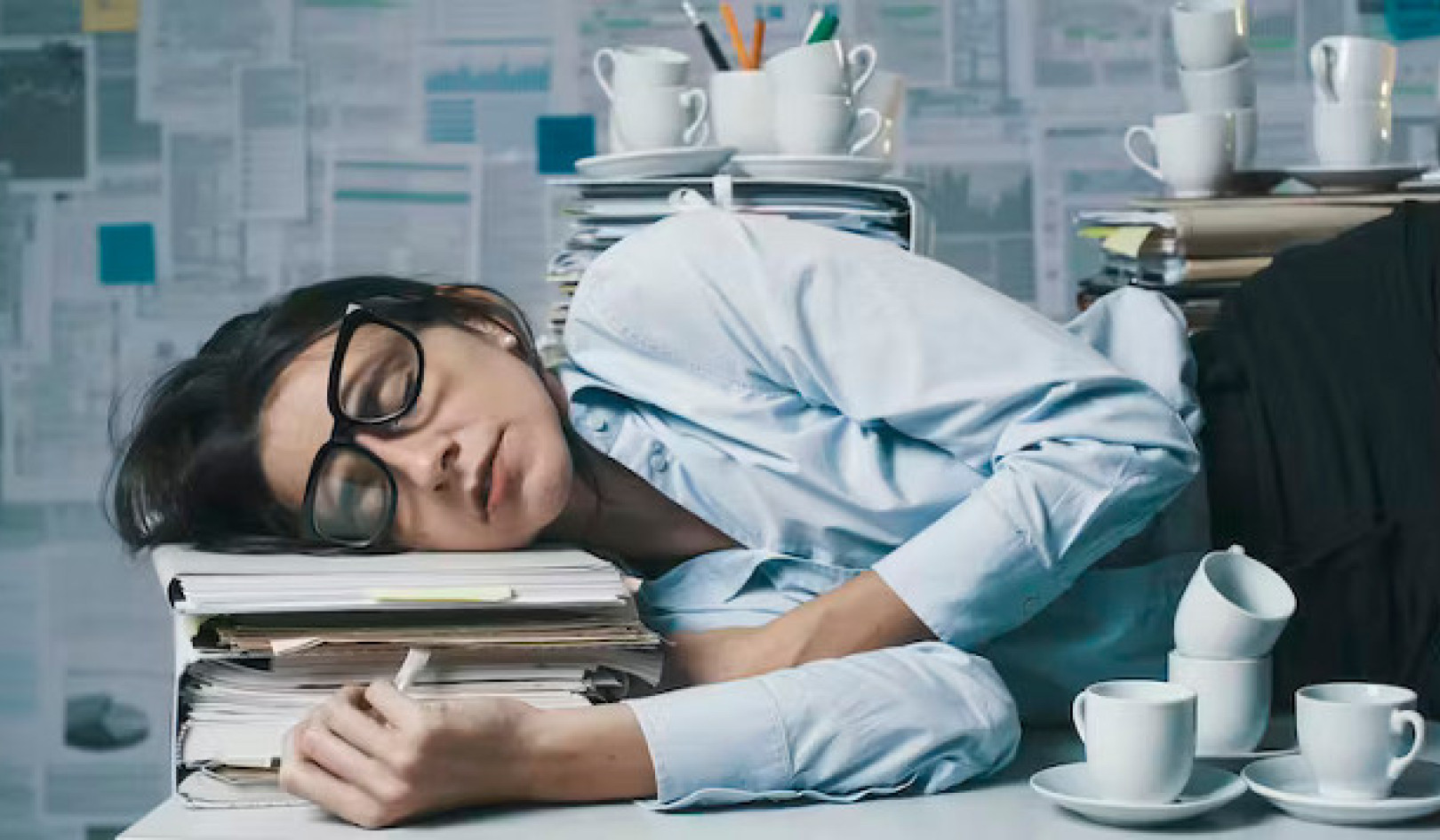
Busy August, quiet September. EPA
England is about to re-impose nationwide restrictions on gatherings to control the spread of COVID-19. This comes less than two weeks after the end of the government’s half-a-billion-pound scheme to get people to eat out in restaurants. Depending on how things go, we may look back on this scheme as the first step towards a second lockdown.
During August, the UK government ran the Eat Out to Help Out scheme to get cash into the hands of hospitality businesses, boost confidence and encourage people back to the high street.
The government offered restaurant-goers a 50% discount on their meal, up to £10 per person, to eat out on Mondays, Tuesdays and Wednesdays. Over the month, the government spent £522 million of taxpayers’ money on more than 100 million of these subsidised meals.
Now that the scheme is over we can see if it achieved the government’s goals.
People ate out
It is hard to analyse a scheme like Eat Out to Help Out because people’s activity is volatile for numerous reasons. At the start of July, restaurants were still closed – under government orders.
By the start of August, people were beginning to go out again. So when looking at data in August, the question is: are any changes caused by the scheme, or do they reflect the gradual reopening after the lockdown was lifted in early July?
Because the Eat Out scheme only operated Monday to Wednesday, we can compare it to the other days (Thursday to Sunday) and then compare the difference to the long-run trend. Looking at data from OpenTable, a booking app covering thousands of restaurants, the scheme clearly enticed people to eat out (this data reports 2020 dining levels compared with 2019). Indeed, on days when the scheme was active, people ate out nearly twice as often.
UK restaurant dining, July-August 2020
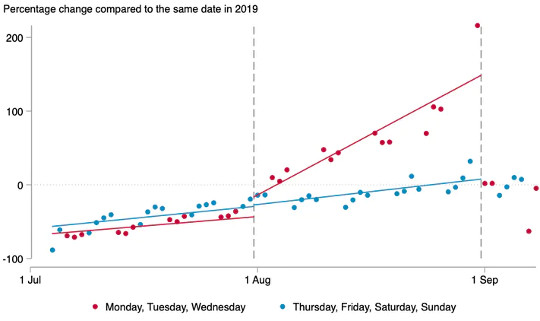 Based on OpenTable data, using author's analysis
Based on OpenTable data, using author's analysis
But we also have to consider the long-term trend: by the start of August, restaurant attendance had already bounced back to near 2019 levels. People were basically going out as normal, so the half-price discount scheme didn’t encourage a “return to normal”; it encouraged extravagant levels of eating out.
Did it help out?
When the scheme was announced, the hospitality response was pleased but cautious: will people stop eating out on the weekends; what will happen after August?
The OpenTable data suggests people still went out on Thursdays to Sundays. Google mobility data, which reports changes in the volume of trips people take to retail, hospitality, recreation and leisure establishments, paints a similar, if less dramatic, picture in the chart below.
Hospitality/retail/leisure footfall, July-August 2020
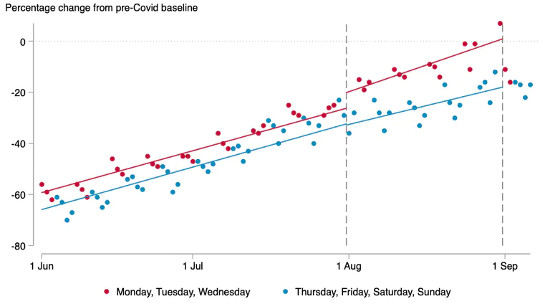 Google mobility data, author's analysis
Google mobility data, author's analysis
But when the scheme ended, things went right back to where they would have been. At the start of September there were more outings than at the start of August, but no more than would have been expected based on the long-term trend of reopening. There seems to be virtually no lasting impact on people’s consumption.
How does that compare with the government’s goals? It definitely got cash into the hands of hospitality businesses (in the short term). It also got people back on the high street (on certain days). And did it boost confidence? Perhaps too much.
Quick fixes have consequences
At the same time as the scheme was operating, the UK started to see an uptick in COVID-19 cases. This overwhelmed testing capacity and caused some regions to reimpose restrictions.
It’s impossible to know what caused this: people were also coming back from summer holidays and spending more time with friends. Indeed, transmission rates were already creeping up in early August, before there could have been any effect from the Eat Out scheme. But the rapid acceleration in the proportion of detected positive cases at the start of September is consistent with cases where infection occurred in mid-August.
It’s certainly worth considering the effect of a £10 discount at the pub. And the effect of concentrating people’s outings on just three days of the week.
Positive cases as a % of tests carried out
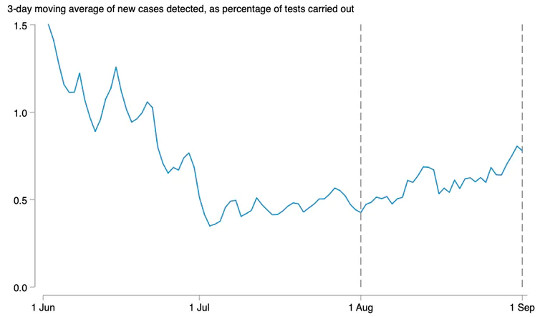 UK government data/author's analysis
UK government data/author's analysis
Looking at the English regions, there is a loose correlation between uptake of the scheme and new cases in the last weeks of August. Again, this isn’t to say that the scheme caused those cases. But it certainly didn’t discourage those people from going out.
Eat Out uptake and COVID transmission by region
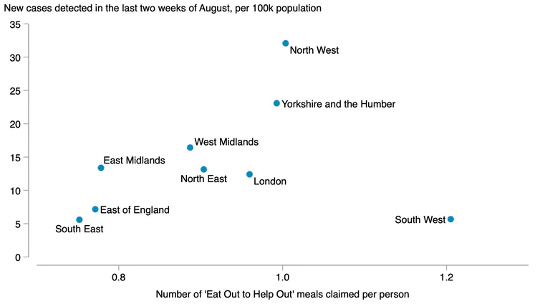 New cases detected in the last two weeks of August, per 100,000 of population. UK government data/author's analysis
New cases detected in the last two weeks of August, per 100,000 of population. UK government data/author's analysis
Footing the bill
The Eat Out scheme was a creative way to get money to struggling hospitality businesses, and that’s no small feat. But the party comes with a hangover. Businesses that hired new staff to manage extra demand face the prospect of even tighter restrictions (as is already happening in Bolton in north-west England). Not to mention a potential second lockdown, particularly given the “pubs or schools” debate, with the government indicating it would sooner close pubs and restaurants if forced to choose.
In future, policymakers should heed the lessons from this experience. Rather than trying to encourage a big-bang “back to normal”, governments should settle in for the long haul: encouraging and establishing patterns of behaviour that are safe and consistent with a pandemic.
If the goal is to financially support businesses, many countries have simply continued to give them loans, debt relief or payroll subsidies. If the goal is to get people out and spending on high streets, policies should be designed to keep people spread out (for example, allowing people to spread consumption across the week, and including take-out).
And if the goal is to boost confidence so that people return to normal, well maybe we just can’t do that yet.![]()
About the Author
Toby Phillips, Public Policy Researcher, University of Oxford
This article is republished from The Conversation under a Creative Commons license. Read the original article.
Related Books:
The Body Keeps the Score: Brain Mind and Body in the Healing of Trauma
by Bessel van der Kolk
This book explores the connections between trauma and physical and mental health, offering insights and strategies for healing and recovery.
Click for more info or to order
Breath: The New Science of a Lost Art
by James Nestor
This book explores the science and practice of breathing, offering insights and techniques for improving physical and mental health.
Click for more info or to order
The Plant Paradox: The Hidden Dangers in "Healthy" Foods That Cause Disease and Weight Gain
by Steven R. Gundry
This book explores the links between diet, health, and disease, offering insights and strategies for improving overall health and wellness.
Click for more info or to order
The Immunity Code: The New Paradigm for Real Health and Radical Anti-Aging
by Joel Greene
This book offers a new perspective on health and immunity, drawing on principles of epigenetics and offering insights and strategies for optimizing health and aging.
Click for more info or to order
The Complete Guide to Fasting: Heal Your Body Through Intermittent, Alternate-Day, and Extended Fasting
by Dr. Jason Fung and Jimmy Moore
This book explores the science and practice of fasting offering insights and strategies for improving overall health and wellness.























